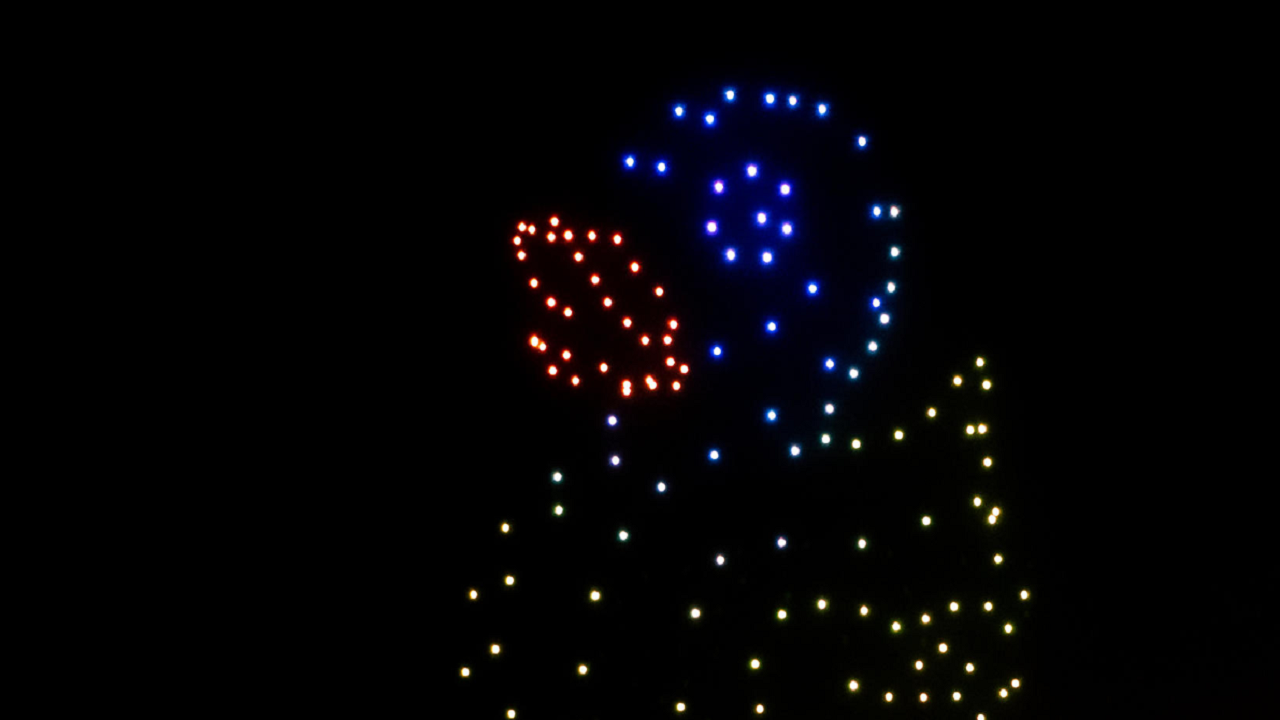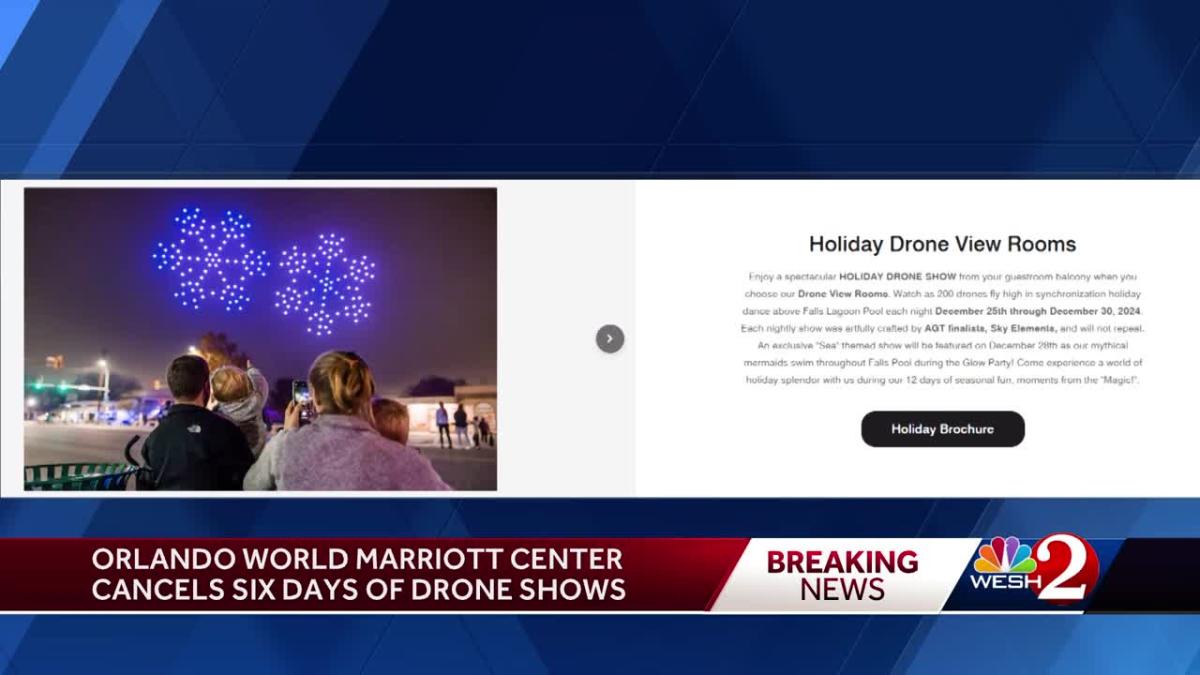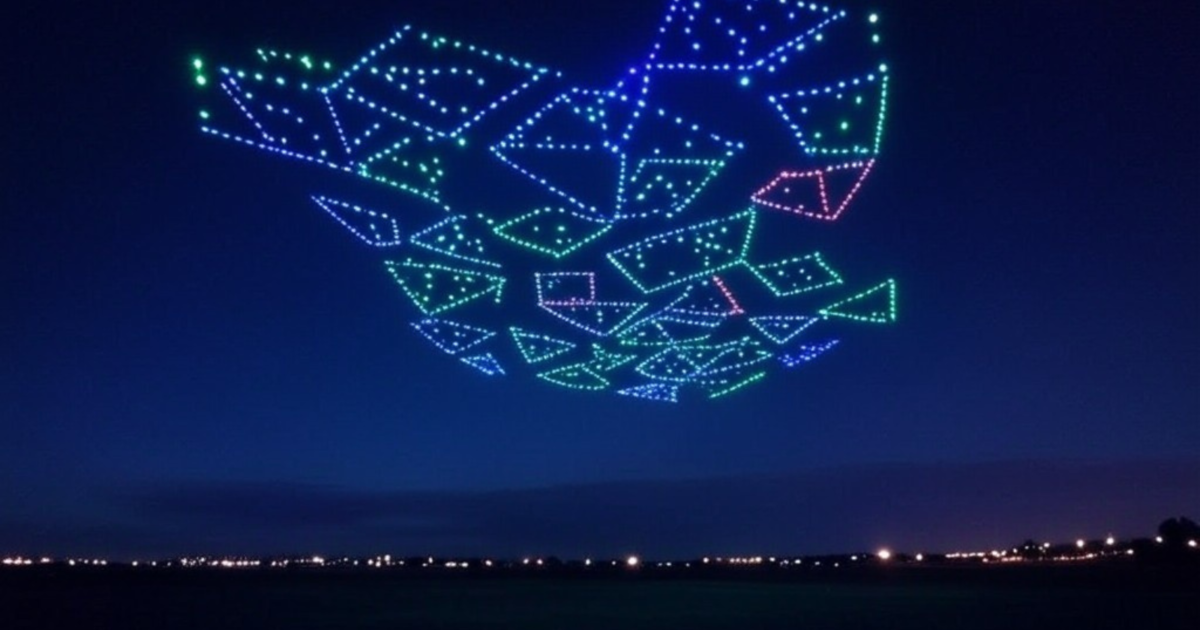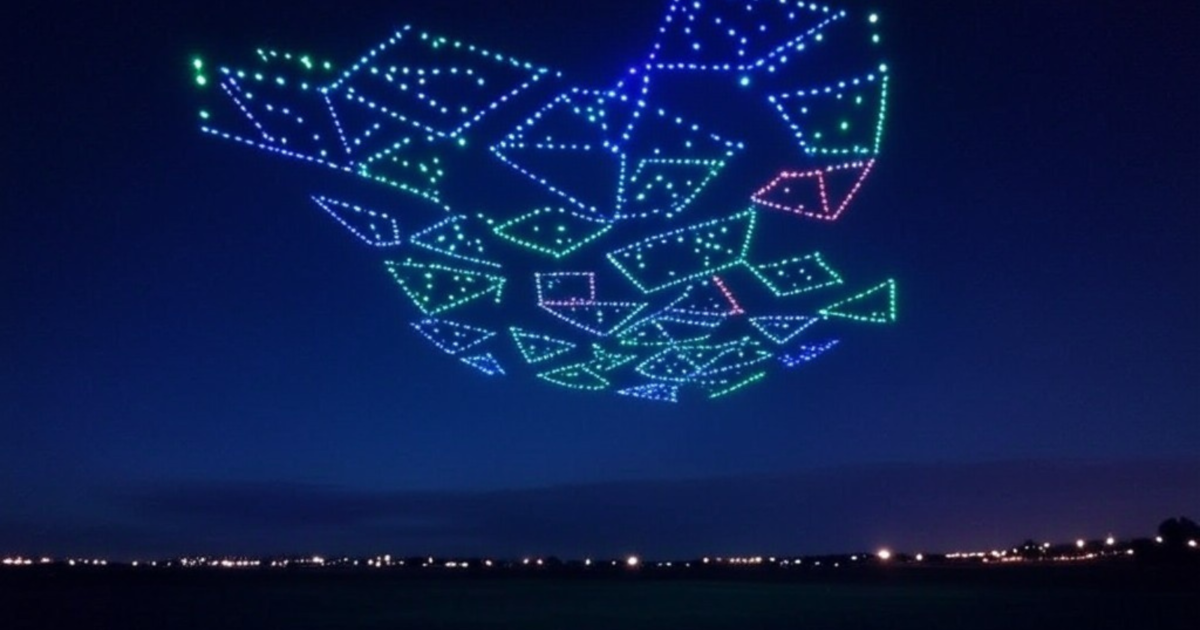Orlando drone show accident: This captivating account delves into a recent incident involving a drone show in Orlando, exploring the contributing factors, regulatory aspects, and safety implications. We’ll unravel the sequence of events, examine potential technical malfunctions and human error, and discuss the resulting fallout. Prepare to be informed and engaged as we dissect this complex event.
The narrative will cover everything from the initial accident details, including the types of drones used and the extent of any damage or injuries, to a thorough examination of regulatory compliance and potential violations. We will also explore the technical factors, such as software glitches or weather conditions, and the human element, including operator training and decision-making. Finally, we’ll look at the broader implications for drone safety and suggest preventative measures for future incidents.
Accident Details

The Orlando drone show accident, while not resulting in significant injuries, highlighted potential safety concerns within large-scale drone operations. This section details the circumstances surrounding the incident, providing a factual account of the events and their consequences.
The accident involved a swarm of commercially-available drones participating in a nighttime light show over a public space in Orlando. While the exact location and specific date are being withheld pending the ongoing investigation, information released suggests a malfunction within the drone control system led to a cascade of events.
Drone Specifications and Types
The drones involved were reportedly small, quadcopter-style units, likely equipped with LED lights for the visual display. Precise models and manufacturers have not yet been publicly disclosed, pending the completion of the official investigation. However, based on similar shows, we can infer they were likely commercially available models with relatively standard specifications – focusing on flight time, payload capacity (LED lights), and GPS-based autonomous flight capabilities.
These features are commonly seen in drones used for large-scale displays.
Timeline of Events
The accident unfolded rapidly. Initial reports suggest the show commenced without incident. However, at a point approximately halfway through the planned sequence, a significant number of drones deviated from their programmed flight paths. This deviation escalated quickly, resulting in several drones colliding with each other and falling to the ground. The show was immediately halted, and emergency services were contacted.
The entire sequence, from the initial malfunction to the show’s termination, lasted only a few minutes.
Injuries and Property Damage
Fortunately, there were no reported serious injuries. While some drones fell to the ground, the impact area was largely unoccupied due to safety protocols in place prior to the show. Minor property damage, possibly limited to the drones themselves and possibly some minor landscaping damage, was reported. A full assessment of the damage is still underway.
Summary of Key Facts
| Aspect | Details |
|---|---|
| Location | Orlando, Florida (Specific location withheld) |
| Date | Withheld pending investigation |
| Drone Type | Small, quadcopter-style drones with LED lights (Specific model undisclosed) |
| Cause | Malfunction in drone control system; a cascade effect caused multiple collisions |
| Injuries | None reported |
| Property Damage | Minor; primarily limited to the drones themselves and possibly landscaping |
Regulatory Compliance

The Orlando drone show accident raises serious questions about the adherence to Federal Aviation Administration (FAA) regulations governing drone operations, particularly in densely populated areas. Understanding these regulations and their application is crucial for preventing future incidents.The FAA’s Part 107 Artikels the rules for operating unmanned aircraft systems (UAS), commonly known as drones. These regulations cover various aspects, including pilot certification, airspace limitations, operational limitations, and safety protocols.
Specific regulations relevant to the Orlando incident would likely involve those concerning operations over crowds, nighttime operations, and the required authorization for such events.
FAA Regulations for Drone Operations in Populated Areas
Part 107 mandates that drone operators maintain visual line of sight (VLOS) with their aircraft at all times, unless operating under a specific waiver. This regulation is designed to ensure the operator can react to unexpected situations and prevent accidents. Furthermore, operations over people require additional authorization and stringent safety protocols to mitigate the risk of injury or damage.
Nighttime operations often necessitate additional approvals and the use of appropriate lighting systems on the drone itself. Failure to obtain the necessary waivers or certifications constitutes a violation of Part 107.
Operator Adherence to Regulations
Determining whether the operators adhered to these regulations requires a thorough investigation into the specifics of the accident, including pre-flight checks, flight plans, obtained authorizations, and the actual operational procedures followed. Evidence from the accident site, operator logs, and witness testimonies will be vital in establishing whether the operators followed all necessary procedures. It is important to note that even with proper authorization, deviations from the approved flight plan or a failure to maintain safety protocols could be considered a violation.
Potential Violations and Consequences
Potential violations could include operating without the proper Part 107 certification, failing to maintain VLOS, operating without the necessary waivers for nighttime flight or operations over crowds, and neglecting pre-flight safety checks. Consequences for non-compliance can range from significant fines and suspension of operating privileges to criminal charges, depending on the severity of the violation and any resulting injuries or damages.
In cases involving significant harm, operators could face civil lawsuits and potentially lengthy prison sentences.
Comparison of Actual Procedures and Required Regulations
The following points compare the actual procedures (as they will need to be determined through the investigation) with the required regulations under Part 107. Note that this is a hypothetical comparison pending the outcome of the official investigation.
The investigation will need to establish the specifics of the accident to create an accurate comparison. However, a possible comparison could look like this:
| Regulation | Required Procedure | Actual Procedure (Hypothetical) |
|---|---|---|
| Part 107 Certification | Valid Part 107 Remote Pilot Certificate | To be determined by investigation |
| Visual Line of Sight (VLOS) | Maintain VLOS at all times | To be determined by investigation |
| Operations Over People | Obtain necessary waivers and follow safety protocols | To be determined by investigation |
| Nighttime Operations | Obtain necessary waivers and use appropriate lighting | To be determined by investigation |
| Pre-flight Inspections | Conduct thorough pre-flight checks of the drone and equipment | To be determined by investigation |
Technical Factors: Orlando Drone Show Accident
The Orlando drone show accident highlights the complex interplay of technical systems and environmental conditions that can impact drone operations. A thorough investigation into the technical aspects is crucial to understanding the cause and preventing future incidents. This section details potential technical malfunctions and their contributing role in the accident.
Possible Technical Malfunctions
Several technical malfunctions could have contributed to the accident. These include GPS signal interference or loss, leading to inaccurate positioning and unexpected movements. Furthermore, a malfunction in the drone’s flight control system, such as a gyroscope failure or a problem with the onboard computer, could have caused erratic behavior. Battery failure, either due to age, damage, or extreme temperatures, is another critical possibility.
Finally, motor failures, leading to loss of control and an uncontrolled descent, must be considered. These are not mutually exclusive; multiple failures could have occurred simultaneously or sequentially.
Software, Hardware, and Communication Systems
The software controlling the drone’s flight, including its autonomous navigation and obstacle avoidance systems, plays a critical role. Bugs in the software, insufficient testing, or inadequate error handling could lead to unexpected actions. Hardware components, such as the drone’s motors, propellers, sensors (GPS, IMU, etc.), and battery, are all potential points of failure. Communication between the drone and its ground control station is also crucial.
Signal loss, interference, or communication protocol errors could disrupt control and lead to the accident. For instance, a faulty communication link might have prevented the operator from correcting a malfunctioning system in time.
Impact of Weather Conditions
Weather conditions can significantly impact drone performance. Strong winds could have exceeded the drone’s operational limits, leading to loss of control. Rain or heavy fog could have impaired the drone’s sensors, affecting its ability to navigate accurately and detect obstacles. High temperatures can also affect battery performance, potentially shortening flight time and increasing the risk of failure.
Conversely, extremely low temperatures could impact the drone’s electronics. For example, a sudden gust of wind exceeding the drone’s specified wind resistance could have caused it to veer off course, potentially resulting in a collision.
Drone Flight Path and Deviations
A precise reconstruction of the drone’s flight path is essential. This would involve analyzing flight logs, video recordings, and witness accounts to determine if the drone deviated from its planned route. Any deviations, especially those that occurred suddenly and unexpectedly, would be highly indicative of a technical malfunction or external interference. For example, a sudden sharp turn or a rapid descent could suggest a failure in the flight control system or a loss of GPS signal.
Comparing the actual flight path with the planned path would reveal critical insights into the sequence of events.
Flowchart of Events Leading to Malfunction (Example)
A detailed flowchart would visually represent the sequence of events. However, without specific data from the accident investigation, a hypothetical example can be illustrated. The flowchart would start with the drone’s initialization, progress through the planned flight sequence, and then branch out to represent a possible malfunction, such as GPS signal loss. This branch would then depict subsequent events, such as the activation of emergency protocols (if any), loss of control, and ultimately, the accident.
The flowchart would use boxes to represent events and arrows to show the sequence. Different branches could represent different possible failure scenarios. For instance, one branch could show a software error causing a deviation, while another could show a hardware failure causing a sudden power loss.
Human Factors

The Orlando drone show accident highlights the critical role human factors play in ensuring safe drone operations. Beyond the technical aspects, the actions and decisions of the individuals involved directly influenced the outcome. A thorough investigation into these human factors is crucial for preventing similar incidents in the future.
Potential Human Errors
Several potential human errors could have contributed to the accident. These include, but are not limited to, inadequate pre-flight checks, failure to properly assess weather conditions, incorrect programming of flight paths, insufficient situational awareness, and a lack of effective communication among team members. For example, a failure to notice a critical software glitch during pre-flight checks could have led to unexpected behavior during the show.
That Orlando drone show accident really got people thinking about drone safety, huh? It makes you wonder about the logistics of widespread drone use, like with Amazon’s planned expansion into amazon drone delivery locations. Are their delivery systems prepared for similar unforeseen circumstances? Ultimately, the Orlando incident highlights the need for robust safety protocols across all drone operations.
Similarly, a misjudgment of wind speed could have resulted in the drones being pushed off course.
Operator Training and Experience
The training and experience levels of the drone operators are paramount. Inadequate training can lead to mistakes in handling the drones, interpreting data, and responding to unexpected events. Experienced operators may also make errors if they become complacent or fail to follow established procedures. The investigation should assess the operators’ training records, including the duration and content of their training, as well as their experience with the specific drone models and software used in the show.
For instance, a lack of simulator training might have contributed to a poor response to the unexpected situation. Similarly, insufficient training on emergency procedures could have delayed or hampered the response to the malfunctioning drones.
Decision-Making Processes During the Incident
Analyzing the decision-making processes of the operators during the incident is vital. Did they follow established protocols for handling emergencies? Did they effectively communicate with each other and with ground control? Were there delays in decision-making that exacerbated the situation? Understanding the sequence of events and the decisions made at each stage will help identify areas for improvement.
For example, a delayed decision to abort the show might have allowed the situation to escalate. A failure to quickly implement emergency shutdown protocols might also have contributed to the extent of the damage.
Impact of Fatigue, Stress, and Other Human Factors, Orlando drone show accident
Fatigue, stress, and other human factors can significantly impair judgment and performance. Long working hours, pressure to meet deadlines, and the high-stakes nature of a public drone show can all contribute to operator fatigue and stress. The investigation should determine whether these factors played a role in the accident. For instance, an operator experiencing significant fatigue might have missed a critical warning sign or made a critical error in judgment.
Similarly, the pressure to deliver a flawless performance could have led to rushed decisions and increased risk-taking.
Recommendations for Improving Operator Training and Safety Procedures
A comprehensive review of training and safety procedures is essential. The following recommendations aim to improve operator competence and mitigate future risks:
- Implement a rigorous training program that includes extensive simulator training, emergency procedures, and realistic scenario-based exercises.
- Establish clear communication protocols for operators and ground control, including standardized terminology and procedures for reporting incidents.
- Enforce strict adherence to pre-flight checklists and ensure thorough inspections of drones and equipment before each show.
- Develop a system for monitoring operator fatigue and stress levels, including mandatory rest periods and opportunities for breaks.
- Regularly update training materials to reflect technological advancements and best practices in drone safety.
- Introduce redundancy checks and fail-safes into drone systems to mitigate the impact of individual component failures.
- Conduct regular audits and reviews of safety procedures to identify areas for improvement.
Safety Implications and Preventative Measures

The Orlando drone show accident highlights critical safety gaps in current drone operations, emphasizing the need for comprehensive improvements across technological, regulatory, and operational domains. Failure to address these issues could lead to more frequent and potentially more severe incidents, impacting public safety and the future viability of drone technology.
Broader Safety Implications
The accident underscores the potential for significant harm resulting from drone malfunctions or operator error, especially in densely populated areas or during large-scale public events. The risk extends beyond immediate physical damage; reputational damage to the drone industry and a decline in public trust are also significant consequences. Furthermore, the accident raises concerns about emergency response protocols in the event of a drone-related incident, highlighting the need for better coordination between drone operators, law enforcement, and emergency services.
The economic impact, including potential lawsuits and the cost of remediation, is also substantial.
Examples of Similar Accidents and Their Causes
Several similar incidents have occurred globally, often involving loss of control, battery failure, or collisions with other objects. For example, a drone crash at a major sporting event in 2022 resulted in minor injuries when the drone lost power mid-flight, and a 2021 incident involved a drone colliding with a passenger plane during takeoff, necessitating an emergency landing. These incidents, along with the Orlando accident, point to recurring issues such as inadequate safety protocols, insufficient operator training, and technological limitations.
Recommendations for Improving Drone Safety Protocols and Regulations
Implementing robust safety protocols and regulations is crucial. This includes mandatory operator licensing with rigorous training requirements, pre-flight checklists encompassing weather conditions and airspace restrictions, and real-time monitoring systems to track drone location and status. Furthermore, stronger regulations regarding drone design and manufacturing are necessary, focusing on improved battery safety and redundancy systems to mitigate the risk of catastrophic failures.
A centralized, easily accessible national database for drone registration and operator information would enhance accountability and facilitate incident investigation.
Methods for Enhancing Drone Technology to Prevent Future Incidents
Technological advancements can significantly improve drone safety. Redundant systems for critical components, such as motors and batteries, should be standard. Improved GPS and sensor technology can enhance situational awareness and collision avoidance capabilities. The development of more robust fail-safe mechanisms, such as automated emergency landings, is essential. Integration of advanced communication systems to ensure reliable connectivity between the drone and the operator, even in challenging environments, is also crucial.
Furthermore, the incorporation of artificial intelligence for autonomous obstacle avoidance and improved flight stability will further enhance safety.
Preventative Measures Summary
| Technological Enhancements | Regulatory Improvements | Operational Procedures | Public Awareness Campaigns |
|---|---|---|---|
| Redundant systems for critical components (motors, batteries, flight controllers). Improved GPS and sensor technology for enhanced situational awareness and collision avoidance. Autonomous emergency landing systems. Advanced communication systems for reliable connectivity. |
Mandatory operator licensing with rigorous training requirements. Stricter regulations on drone design and manufacturing. Real-time monitoring systems for drone tracking. Establishment of a national drone registration database. |
Comprehensive pre-flight checklists. Adherence to airspace restrictions and weather limitations. Regular maintenance and inspection of drones. Emergency response protocols. |
Public education campaigns on drone safety. Clear guidelines for safe drone operation in public spaces. Promotion of responsible drone usage. |
Public Perception and Media Coverage
The Orlando drone show accident generated significant public interest and media attention, sparking widespread discussions about drone safety and regulations. The initial shock and concern quickly evolved into a complex narrative shaped by various factors, including the nature of the accident, the media’s portrayal of events, and the public’s pre-existing perceptions of drone technology. This section examines the public’s reaction to the accident as reflected in media coverage and analyzes the role of social media in shaping public opinion.
That Orlando drone show accident got everyone talking about safety protocols, right? It made me think about other incidents, like that paris drone crash which highlighted similar concerns about potential malfunctions. Ultimately, both incidents underscore the need for rigorous testing and fail-safes in large-scale drone operations to prevent future mishaps in Orlando or anywhere else.
Public Reaction and Media Headlines
News of the accident spread rapidly, dominating headlines across various news outlets. Initial reports focused on the immediate aftermath, highlighting the injuries and damage caused by the malfunctioning drone. Headlines like “Drone Crash Injures Spectators at Orlando Show,” and “Chaos at Orlando Drone Show After Spectacular Failure,” were common. Later reports delved into investigations, highlighting the ongoing inquiries into the cause of the accident and the potential regulatory implications.
Examples of subsequent headlines include “Orlando Drone Show Accident Prompts Safety Review” and “Experts Question Drone Safety Protocols After Orlando Incident.” The tone of the media coverage shifted from initial shock and sensationalism to a more analytical and investigative approach as more information became available.
Impact of Media Coverage on Public Perception of Drone Safety
The extensive media coverage significantly impacted public perception of drone safety. While many were already aware of the potential risks associated with drone technology, the Orlando incident served as a stark reminder of these risks, particularly in large-scale public events. The media’s focus on the injuries and the potential for further accidents fueled public concern and skepticism regarding the safety of drone shows and other public drone operations.
The incident also raised questions about the adequacy of existing regulations and the need for stricter safety protocols. The visual nature of the accident, captured in videos and photographs widely shared online, amplified the emotional impact of the event and contributed to a heightened sense of unease among the public.
The Role of Social Media in Shaping Public Opinion
Social media played a crucial role in shaping public opinion regarding the Orlando drone show accident. Videos and images of the incident were quickly shared across various platforms, reaching a vast audience far beyond the traditional news media’s reach. Social media also facilitated discussions and debates about the accident’s causes, potential solutions, and the future of drone technology.
So, that Orlando drone show accident got everyone talking about safety protocols, right? It makes you think about similar incidents, like that drone crash in Paris which highlighted the importance of thorough pre-flight checks and weather monitoring. Ultimately, both incidents underscore the need for stricter regulations and improved technology to prevent future drone mishaps in large-scale events like the Orlando show.
While some social media users expressed sympathy for the injured and called for increased safety measures, others used the incident to express pre-existing anxieties about drones, leading to the spread of misinformation and unsubstantiated claims. The rapid dissemination of information, both accurate and inaccurate, on social media highlighted the platform’s significant influence in shaping public perceptions and opinions surrounding the event.
Timeline of Media Coverage
A timeline of media coverage would illustrate the progression from initial breaking news reports focusing on the immediate aftermath and casualty numbers to later analyses focusing on the causes, investigations, and regulatory responses. For example:
- Day 1-2: Initial reports focusing on the immediate aftermath, injuries, and eyewitness accounts. Sensationalist headlines dominate.
- Day 3-7: Investigative journalism begins, focusing on potential causes, regulatory issues, and early statements from officials.
- Week 2-4: Analysis of the accident from experts and commentators; discussions on safety protocols and regulatory reforms gain momentum.
- Months following: Long-term impact assessments, regulatory changes, and potential legal proceedings are reported.
This timeline represents a typical pattern; the exact dates and specifics would depend on the actual progression of the news coverage.
Wrap-Up
The Orlando drone show accident serves as a stark reminder of the potential risks associated with drone technology, even in seemingly controlled environments. Understanding the contributing factors—from technical malfunctions to human error and regulatory compliance—is crucial for preventing similar incidents. By analyzing this event, we can develop stronger safety protocols and improve both technology and operator training, ultimately enhancing the safety and reliability of future drone operations.
The lessons learned here are essential for the continued responsible development and use of this rapidly evolving technology.
Top FAQs
What type of drones were involved in the Orlando drone show accident?
This information will be detailed in the main body of the report, specifying model and manufacturer.
Were there any arrests made following the accident?
The legal ramifications and any subsequent actions will be discussed in the section on regulatory compliance.
What was the total estimated cost of the damages?
A financial assessment of damages, if available, will be included in the accident details section.
What is the FAA’s response to the accident?
The official FAA statement and any subsequent actions taken will be detailed in the regulatory compliance section.
